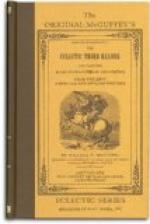Produced by Don Kostuch
[Transcriber’s Notes:
Welcome to the schoolroom of 1900. The moral tone is plain. “She is kind to the old blind man.”
The exercises are still suitable, and perhaps more helpful than some contemporary alternatives. Much is left to the teacher. Explanations given in the text are enough to get started teaching a child to read and write. Counting in Roman numerals is included as a bonus in the form of lesson numbers.
The author, not listed in the text is William Holmes McGuffey.
Don Kostuch
]
ECLECTIC EDUCATIONAL SERIES.
MCGUFFEY’S(R)
SECOND
Eclectic Reader.
Revised edition.
McGuffey Editions and Colophon are Trademarks of
John Wiley & Sons, Inc..
New York — Chichester-Weinheim-Brisbane-Singapore-Toronto
Copyright, 1879, by Van Antwerp, Bragg & Co.
Copyright, 1896, by American Book Company
Copyright, 1907 and 1920, by H. H. Vail.
EP316
Preface
In this book, as well as in the others of the Revised Series, most of the favorite drill selections, which constituted one of the leading excellences of MCGUFFEY’S readers, have been retained. New selections have been inserted only when they seemed manifest improvements on those formerly used.
The plan of this Reader is a continuation and extension of that pursued in the First Reader.
If the pupil is not familiar with the diacritical marks, he should be carefully drilled, as suggested on page 7, until the marked letter instantly suggests the correct sound. He is then prepared to study his reading lessons without any assistance from the teacher.
All new words are given at the head of each lesson. When these are mastered, the main difficulties left for the pupil are those of expression. In the latter portion of the book the simpler derivatives,—such as are formed by adding one or two letters,—possessives, plurals, verbal forms, etc.,—are omitted if the primitive word has been given. In this way the pupil is gradually led to the mastery of words as ordinarily printed.
A few of the most usual abbreviations have been introduced,—such as Mr., Mrs., etc. These should be carefully explained, not only as to their meaning and use, but as to the reason for their use.
Great care has been taken to have the illustrations worthy of the reputation MCGUFFEY’S readers have attained, and some of the foremost designers of this country have contributed to the embellishment of the book.
Many of these pictures will serve admirably for lessons in language, in extension and explanation of the text. The imagination of the artist has, in some cases, filled in details not found in the text.




